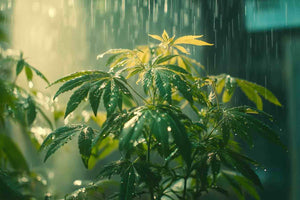
Watering is not that simple, but many growers are under the impression that as long as they soak the cannabis with water every day, it seems that the moisture needs of cannabis can be met.
NONONO, it is not the case.
Too much water can cause serious problems for the plant and hinder the intake of oxygen. On the other hand, too little water can lead to extremely dry conditions, which will make the cannabis plants thirsty and eventually cause them to wither.
Today, we’re diving into everything you need to know to prevent cannabis plant overwatering or underwatering. We’ll cover the signs to watch for, how to correct problems early, and best practices to keep your plants thriving from seedling to harvest.
Why Watering Matters More Than You Think
Water isn’t just a thirst-quencher for your cannabis—it’s the highway for nutrients, the lifeblood of photosynthesis, and a core determinant of cell turgidity and overall plant health. While light, nutrients, air circulation, and humidity all play critical roles, water is often the most overlooked—and the most mishandled.
Many growers assume that daily drenching is a safe bet. But giving your plants water every day without regard for actual soil moisture is a recipe for disaster. Whether you’re unintentionally creating a swamp or leaving your pots bone dry, mistakes in watering lead directly to overwatering weed or drought stress.
The Dangers of Overwatering
What Really Happens When You Over Water Weed
When growing weed, over-watering is an easy mistake to make, most likely due to concerns that plants need a constant dose of water. This is a trap that novices often fall into.
In addition to absorbing water, cannabis plants actually use their roots to breathe air, and if their roots are constantly flooded with water, they will start to drown.
Signs of overwater cannabis plant often show up first in the foliage:
-
Stiff, Curled Leaves
Unlike the limp droop of drought-stressed leaves, an over water weed plants often displays leaves that look swollen, firm, and even curled under themselves. -
Yellowing (Chlorosis)
Overly wet soil disrupts nutrient uptake—especially nitrogen and iron. The result is yellow or pale green leaves, often starting on lower branches. -
Slow or Stunted Growth
With your roots gasping for oxygen, the plant can’t transport nutrients or photosynthate efficiently, so overall growth slows or stops entirely. -
Wilting Despite Moist Soil
Oddly, an overwatered plant can wilt. The leaves can’t maintain turgor when root function is impaired. -
Fungal Issues and Root Rot
Constantly soggy conditions are a haven for pathogens like Pythium and Phytophthora, which cause root rot and further reduce the plant’s ability to absorb water—a vicious cycle.
How to Diagnose Overwatering: Over Water weed plants Symptoms
-
Finger Test: Push your index finger an inch into the soil. If it feels damp, hold off watering.
-
Pot Weight: Lift the pot—if it’s surprisingly heavy, it’s still waterlogged. A dry pot feels much lighter.
-
Visual Clues: Check for pooling water at the pot bottom or soggy topsoil. Look for leaves that are turgid yet drooping or curling.
If you spot two or more of these indicators, you’re likely dealing with over watering weed and need to act quickly.
How to Rescue an Over Water Weed Plant
-
Stop Watering Immediately
Let the medium dry out before supplying any more H₂O. -
Improve Drainage and Aeration
-
Switch to a lighter, well-aerated mix (add perlite, coco coir, or pumice).
-
Ensure your pots have ample drainage holes. Consider elevating them on pot feet or a rack to let water escape freely.
-
-
Increase Airflow
Use clip-on fans or an inline exhaust to promote evaporation and keep humidity in check around the root zone. -
Prune Damaged Foliage
Trim away yellowed or rotting leaves to redirect energy into healthy growth and reduce disease pressure. -
Add Beneficial Microbes
Products containing Trichoderma or mycorrhizal fungi can help restore root health—though they’re a supplement, not a substitute for proper watering.
The Other Extreme—Underwatering
While overwatering weed is a well‐known pitfall, letting your plants dry out too much can be just as harmful.
Signs of Under Watering Weed
-
Limp, Floppy Leaves
Underwatered leaves droop in a limp, lifeless way (no curled firmness like overwatering). -
Crisp or Brown Leaf Edges
Dry, papery margins show that the plant’s transpiration needs aren’t being met. -
Dry, Cracked Soil
The surface becomes hard and cracked; a soil probe or finger goes in with difficulty. -
Light Pot Weight
A very light pot signals a lack of moisture throughout. -
Slow Growth and Reduced Yield
Without adequate water, nutrient transport grinds to a halt, stunting both vegetative growth and flower development.
How to Fix Under Watered Weed Plants
-
Water Thoroughly, But Wisely
When you water, drench until you see runoff—but only if the soil is bone dry first. -
Adjust Pot Size
Small seedlings in giant pots risk over‐drying. Match container size to root mass; upsize gradually. -
Use Mulch or Top-Dressing
A light layer of perlite, vermiculite, or pea gravel on the soil surface can slow evaporation. -
Consider Leaf-Spray Misting
In very dry environments, brief misting can help the plant cope—but don’t substitute for root watering.
Best Practices—The “Dry-Inch” Rule and Beyond
-
“Dry In, Water Out”
Wait until the top 1"–2" (2.5–5 cm) of soil is dry before watering again. This simple guideline helps avoid both over water weed and drought stress. -
Observe Your Plants
No two grows are identical. Pay attention to leaf color, stem rigidity, and overall turgor to gauge needs. -
Choose Quality Growing Media
Mix your own blend with coco coir, perlite, and organic compost to ensure both moisture‐holding capacity and aeration. -
Match Pot Size to Growth Stage
-
Seedlings: 0.5–1 L pots.
-
Vegetative: 3–5 L pots.
-
Flowering: 8–15 L pots.
Too large a pot too soon can lead to pockets of unused water and overwatering cannabis without you even realizing it.
-
-
Maintain Ideal Environment
Keep temperature between 22–28 °C and relative humidity around 40–60 %. This balance helps soil moisture behave predictably.
Part 4: Gear and Gadgets for Hassle-Free Watering
If you’re growing indoors, these tools take the guesswork out of watering:
-
Soil Moisture Sensors
Real-time data on moisture levels, with smartphone alerts so you never accidentally overwatering cannabis.
Conclusion:
Watering cannabis isn’t about dousing daily or rationing to the last drop. It’s about tuning into your plants—reading the leaves, feeling the soil, and responding with just the right touch. Too often, beginner growers over water weed thinking they’re helping, when in reality they’re drowning the roots and stressing the plant.
Next time you reach for the watering can, pause and ask: “Does my plant really need a drink right now?”
If you grow cannabis plants indoor and need a weed Grow Light, you can buy TheOneGrow 640W LED Grow Light. It is professional design for weed cultivation.

